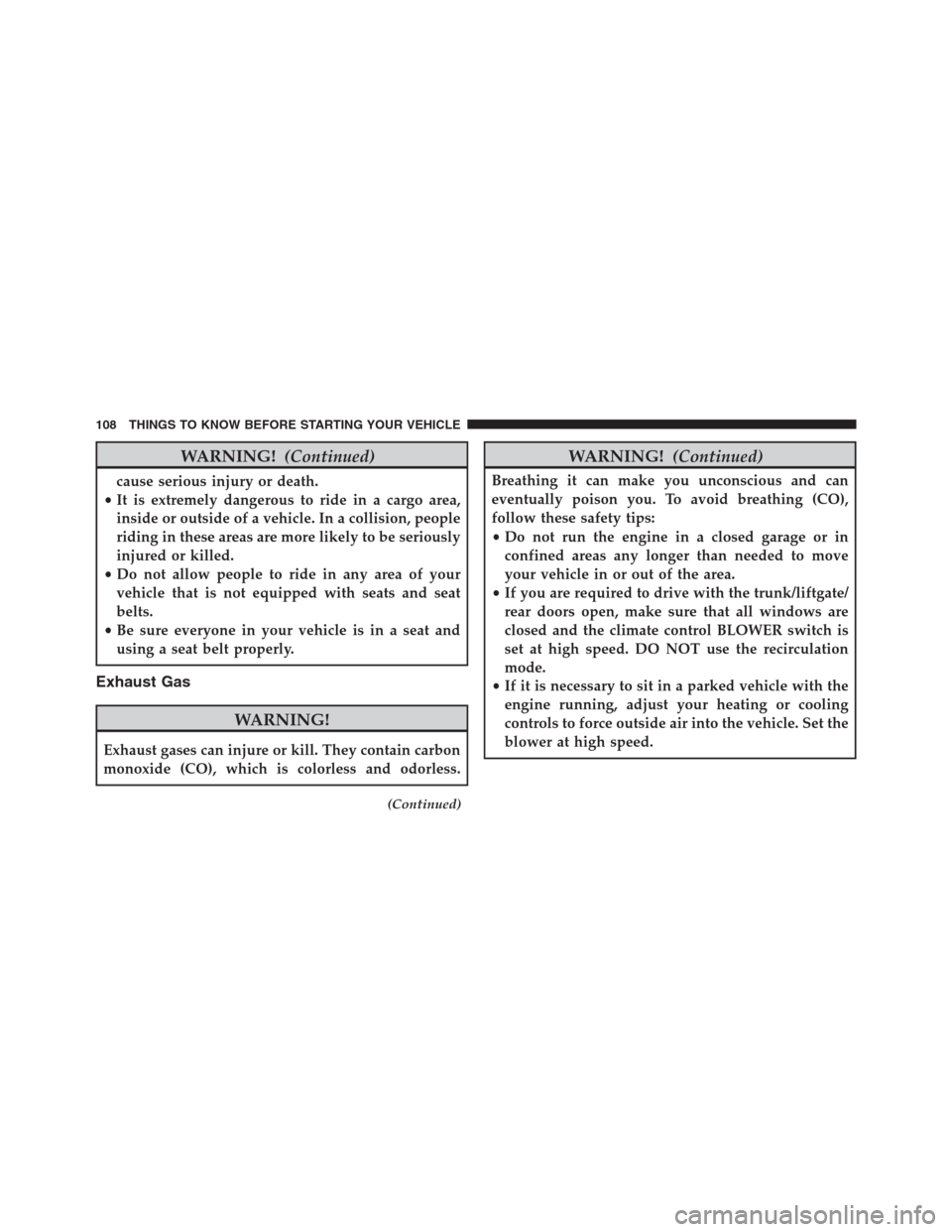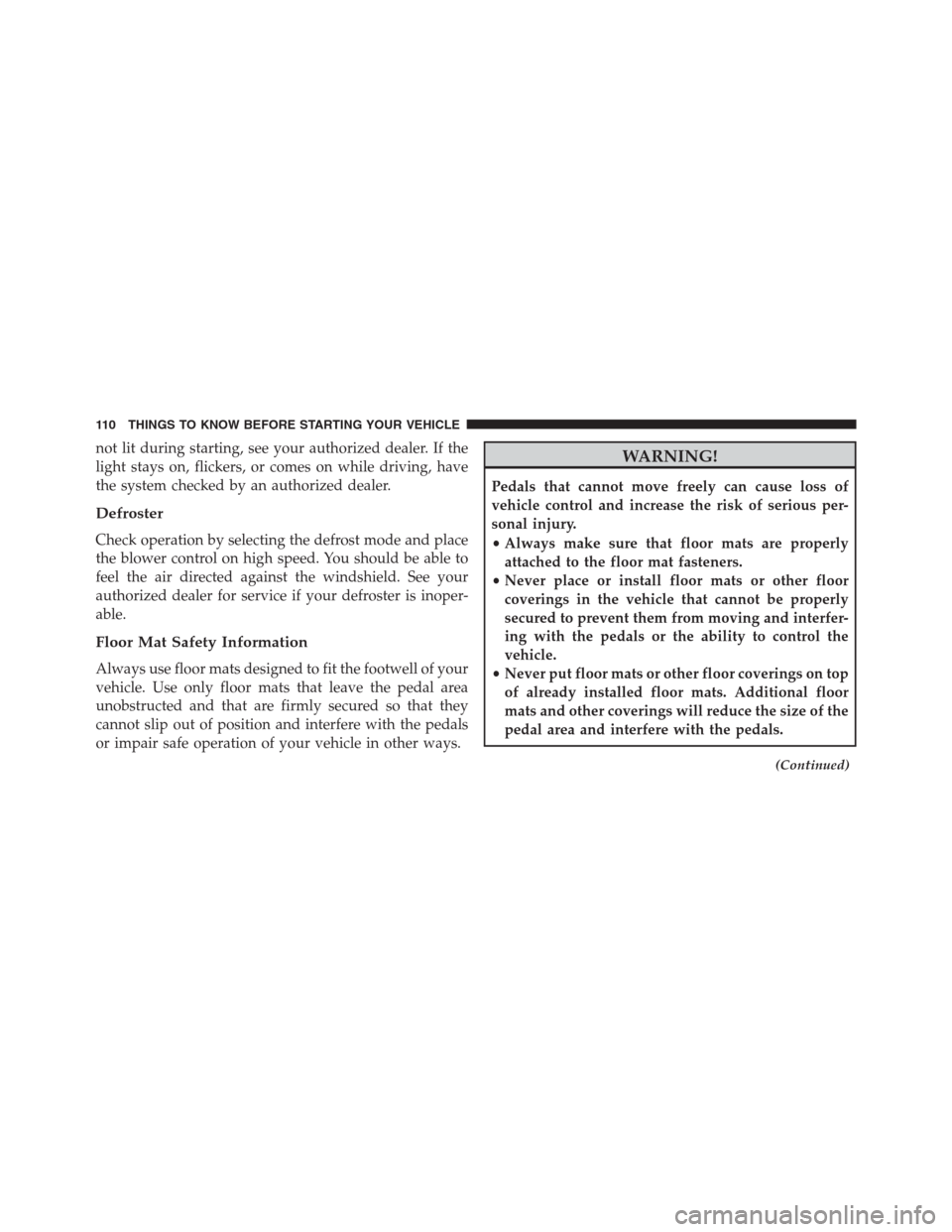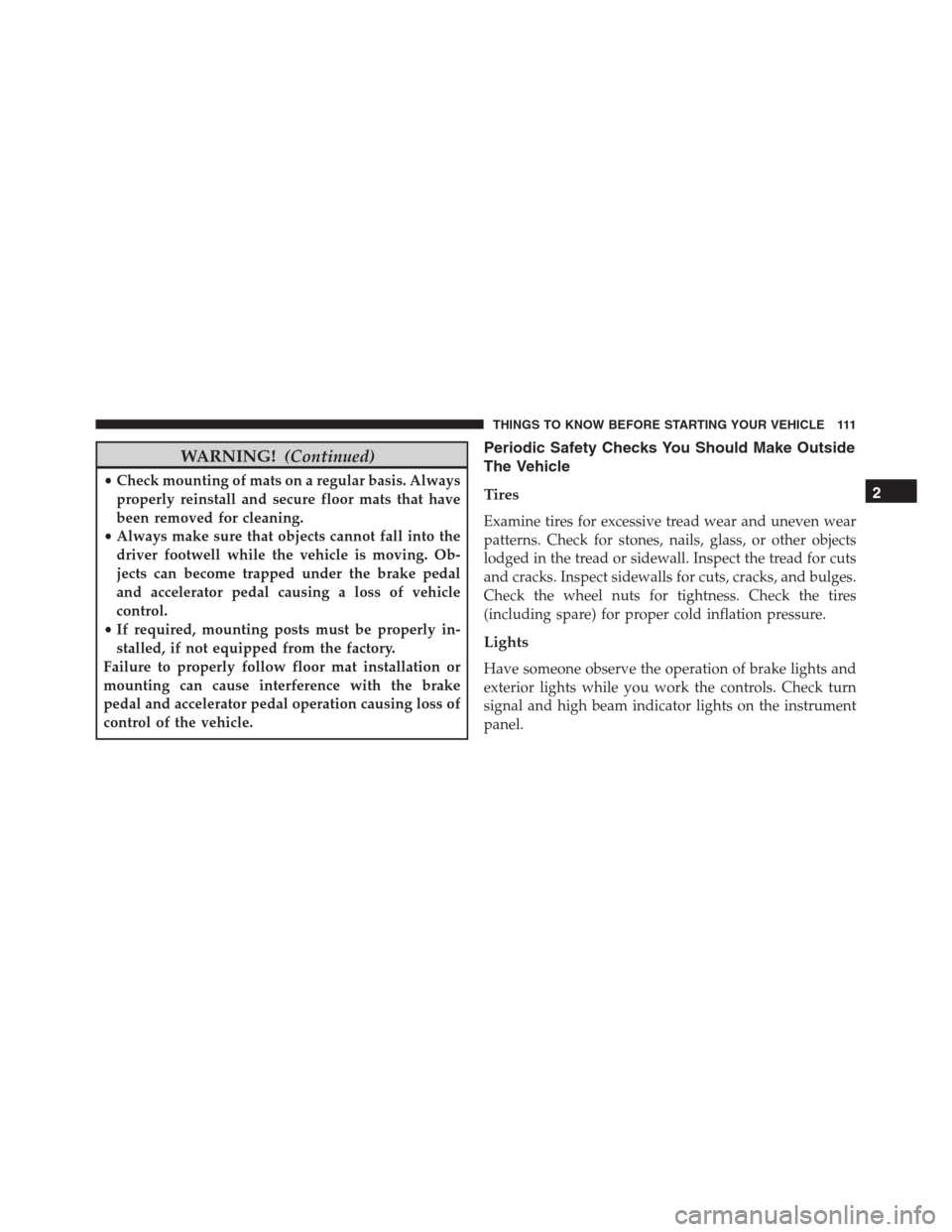Page 109 of 636

100 to 300 miles (161 to 483 km):
•Depress the accelerator pedal slowly and not more
than halfway to avoid rapid acceleration in lower
gears (1st to 3rd gears).
•Avoid aggressive braking.
•Drive with the engine speed less than 5,000 RPM.
•Maintain vehicle speed below 70 mph (112 km/h) and
observe local speed limits.
300 to 500 miles (483 to 805 km):
•Exercise the full engine rpm range, shifting manually
(paddles or gear shift) at higher rpms when possible.
•Do not perform sustained operation with the accelera-
tor pedal at wide open throttle.
•Maintain vehicle speed below 85 mph (136 km/h) and
observe local speed limits.For the first 1500 mi (2414 km):
•Do not participate in track events, sport driving
schools, or similar activities during the first 1500 mi
(2414 km).
NOTE:Check engine oil with every refueling and add if
necessary. Oil and fuel consumption may be higher
through the first oil change interval.
SAFETY TIPS
Transporting Passengers
NEVER TRANSPORT PASSENGERS IN THE CARGO
AREA.
WARNING!
•Do not leave children or animals inside parked
vehicles in hot weather. Interior heat build-up may
(Continued)
2
THINGS TO KNOW BEFORE STARTING YOUR VEHICLE 107
Page 110 of 636

WARNING!(Continued)
cause serious injury or death.
•It is extremely dangerous to ride in a cargo area,
inside or outside of a vehicle. In a collision, people
riding in these areas are more likely to be seriously
injured or killed.
•Do not allow people to ride in any area of your
vehicle that is not equipped with seats and seat
belts.
•Be sure everyone in your vehicle is in a seat and
using a seat belt properly.
Exhaust Gas
WARNING!
Exhaust gases can injure or kill. They contain carbon
monoxide (CO), which is colorless and odorless.
(Continued)
WARNING!(Continued)
Breathing it can make you unconscious and can
eventually poison you. To avoid breathing (CO),
follow these safety tips:
•Do not run the engine in a closed garage or in
confined areas any longer than needed to move
your vehicle in or out of the area.
•If you are required to drive with the trunk/liftgate/
rear doors open, make sure that all windows are
closed and the climate control BLOWER switch is
set at high speed. DO NOT use the recirculation
mode.
•If it is necessary to sit in a parked vehicle with the
engine running, adjust your heating or cooling
controls to force outside air into the vehicle. Set the
blower at high speed.
108 THINGS TO KNOW BEFORE STARTING YOUR VEHICLE
Page 111 of 636

The best protection against carbon monoxide entry into
the vehicle body is a properly maintained engine exhaust
system.
Whenever a change is noticed in the sound of the exhaust
system, when exhaust fumes can be detected inside the
vehicle, or when the underside or rear of the vehicle is
damaged, have a competent mechanic inspect the com-
plete exhaust system and adjacent body areas for broken,
damaged, deteriorated, or mispositioned parts. Open
seams or loose connections could permit exhaust fumes
to seep into the passenger compartment. In addition,
inspect the exhaust system each time the vehicle is raised
for lubrication or oil change. Replace as required.Safety Checks You Should Make Inside The
Vehicle
Seat Belts
Inspect the seat belt system periodically, checking for
cuts, frays, and loose parts. Damaged parts must be
replaced immediately. Do not disassemble or modify the
system.
Front seat belt assemblies must be replaced after a
collision. Rear seat belt assemblies must be replaced after
a collision if they have been damaged (i.e., bent retractor,
torn webbing, etc.). If there is any question regarding seat
belt or retractor condition, replace the seat belt.
Air Bag Warning Light
The light should come on and remain on for
four to eight seconds as a bulb check when the
ignition switch is first turned ON. If the light is
2
THINGS TO KNOW BEFORE STARTING YOUR VEHICLE 109
Page 112 of 636

not lit during starting, see your authorized dealer. If the
light stays on, flickers, or comes on while driving, have
the system checked by an authorized dealer.
Defroster
Check operation by selecting the defrost mode and place
the blower control on high speed. You should be able to
feel the air directed against the windshield. See your
authorized dealer for service if your defroster is inoper-
able.
Floor Mat Safety Information
Always use floor mats designed to fit the footwell of your
vehicle. Use only floor mats that leave the pedal area
unobstructed and that are firmly secured so that they
cannot slip out of position and interfere with the pedals
or impair safe operation of your vehicle in other ways.
WARNING!
Pedals that cannot move freely can cause loss of
vehicle control and increase the risk of serious per-
sonal injury.
•Always make sure that floor mats are properly
attached to the floor mat fasteners.
•Never place or install floor mats or other floor
coverings in the vehicle that cannot be properly
secured to prevent them from moving and interfer-
ing with the pedals or the ability to control the
vehicle.
•Never put floor mats or other floor coverings on top
of already installed floor mats. Additional floor
mats and other coverings will reduce the size of the
pedal area and interfere with the pedals.
(Continued)
110 THINGS TO KNOW BEFORE STARTING YOUR VEHICLE
Page 113 of 636

WARNING!(Continued)
•Check mounting of mats on a regular basis. Always
properly reinstall and secure floor mats that have
been removed for cleaning.
•Always make sure that objects cannot fall into the
driver footwell while the vehicle is moving. Ob-
jects can become trapped under the brake pedal
and accelerator pedal causing a loss of vehicle
control.
•If required, mounting posts must be properly in-
stalled, if not equipped from the factory.
Failure to properly follow floor mat installation or
mounting can cause interference with the brake
pedal and accelerator pedal operation causing loss of
control of the vehicle.
Periodic Safety Checks You Should Make Outside
The Vehicle
Tires
Examine tires for excessive tread wear and uneven wear
patterns. Check for stones, nails, glass, or other objects
lodged in the tread or sidewall. Inspect the tread for cuts
and cracks. Inspect sidewalls for cuts, cracks, and bulges.
Check the wheel nuts for tightness. Check the tires
(including spare) for proper cold inflation pressure.
Lights
Have someone observe the operation of brake lights and
exterior lights while you work the controls. Check turn
signal and high beam indicator lights on the instrument
panel.
2
THINGS TO KNOW BEFORE STARTING YOUR VEHICLE 111
Page 118 of 636

�HEATED STEERING WHEEL — IF EQUIPPED . .182
�ELECTRONIC SPEED CONTROL — IF
EQUIPPED...........................183
▫To Activate..........................184
▫To Set A Desired Speed.................184
▫To Deactivate........................185
▫To Resume Speed.....................185
▫To Vary The Speed Setting...............185
▫To Accelerate For Passing...............186
�ADAPTIVE CRUISE CONTROL (ACC) — IF
EQUIPPED...........................187
▫Adaptive Cruise Control (ACC) Operation. . . .189
▫Activating Adaptive Cruise Control (ACC). . . .190
▫To Activate/Deactivate..................191▫To Set A Desired ACC Speed.............192
▫To Cancel...........................193
▫ToTurnOff..........................193
▫To Resume..........................194
▫To Vary The Speed Setting...............194
▫Setting The Following Distance In ACC......197
▫Overtake Aid........................201
▫ACC Operation At Stop.................201
▫Adaptive Cruise Control (ACC) Menu.......202
▫Display Warnings And Maintenance........203
▫Precautions While Driving With ACC.......206
▫General Information...................210
116 UNDERSTANDING THE FEATURES OF YOUR VEHICLE
Page 119 of 636

▫Normal (Fixed Speed) Electronic Speed Control
Mode..............................210
�FORWARD COLLISION WARNING (FCW) WITH
MITIGATION — IF EQUIPPED............214
▫Forward Collision Warning (FCW) With
Mitigation Operation...................214
▫Turning FCW ON Or OFF...............216
▫Changing FCW And Active Braking Status. . . .217
▫FCW Limited Warning..................218
▫Service FCW Warning..................218
�PARKSENSE® REAR PARK ASSIST — IF
EQUIPPED...........................218
▫ParkSense® Sensors....................219
▫ParkSense® Warning Display.............220▫ParkSense® Display....................220
▫Enabling And Disabling ParkSense®........224
▫Service The ParkSense® Rear Park Assist
System.............................224
▫Cleaning The ParkSense® System..........225
▫ParkSense® System Usage Precautions.......225
�PARKSENSE® FRONT AND REAR PARK ASSIST
— IF EQUIPPED.......................227
▫ParkSense® Sensors....................228
▫ParkSense® Warning Display.............229
▫ParkSense® Display....................229
▫Enabling And Disabling ParkSense®........233
▫Service The ParkSense® Park Assist System . . .234
▫Cleaning The ParkSense® System..........235
3
UNDERSTANDING THE FEATURES OF YOUR VEHICLE 117
Page 127 of 636

WARNING!
•If anyone in the vehicle could be in danger (e.g.,
fire or smoke is visible, dangerous road conditions
or location), do not wait for voice contact from a
9-1-1 operator. All occupants should exit the vehicle
immediately and move to a safe location.
•Never place anything on or near the vehicle’s
wireless and GPS antennas. You could prevent
wireless and GPS signal reception, which can pre-
vent your vehicle from placing an emergency call.
Wireless and GPS signal reception is required for
the 9-1-1 Call system to function properly.
•The 9-1-1 Call system is embedded into the vehi-
cle’s electrical system. Do not add aftermarket
electrical equipment to the vehicle’s electrical sys-
tem. This may prevent your vehicle from sending a
(Continued)
WARNING!(Continued)
signal to initiate an emergency call. To avoid inter-
ference that can cause the 9-1-1 Call system to fail,
never add aftermarket equipment (e.g., two-way
mobile radio, CB radio, data recorder, etc.) to your
vehicle’s electrical system or modify the antennas
on your vehicle. IF YOUR VEHICLE LOSES BAT-
TERY POWER FOR ANY REASON (INCLUDING
DURING OR AFTER AN ACCIDENT), THE
UCONNECT FEATURES, APPS AND SERVICES,
AMONG OTHERS, WILL NOT OPERATE.
•Modifications to any part of the 9-1-1 Call system
could cause the air bag system to fail when you
need it. You could be injured if the air bag system
is not there to help protect you.
3
UNDERSTANDING THE FEATURES OF YOUR VEHICLE 125